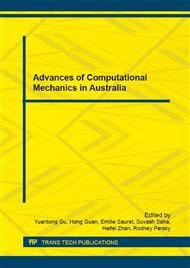[1]
B. Al-Amleh, K. Lyons, M. Swain, Clinical trials in zirconia: a systematic review, J. Oral Rehabil., 37 (2010) 641-652.
DOI: 10.1111/j.1365-2842.2010.02094.x
Google Scholar
[2]
I. Sailer, A. Feher, F. Filser, L.J. Gauckler, H. Luthy, C.H. Hammerle, Five-year clinical results of zirconia frameworks for posterior fixed partial dentures, Int. J. Prosthodont., 20 (2007) 383-388.
Google Scholar
[3]
R. Glauser, I. Sailer, A. Wohlwend, S. Studer, M. Schibli, P. Scharer, Experimental zirconia abutments for implant-supported single-tooth restorations in esthetically demanding regions: 4-year results of a prospective clinical study, Int. J. Prosthodont., 17 (2004).
DOI: 10.1111/cid.12263
Google Scholar
[4]
C.F. Stappert, M. Baldassarri, Y. Zhang, F. Hanssler, E.D. Rekow, P.T. Van, Reliability and fatigue failure modes of implant-supported aluminum-oxide fixed dental prostheses, Clin. Oral Implants Res., 23 (2012) 1173-1180.
DOI: 10.1111/j.1600-0501.2011.02281.x
Google Scholar
[5]
D. Tortopidis, M.F. Lyons, R.H. Baxendale, W.H. Gilmour, The variability of bite force measurement between sessions, in different positions within the dental arch, J. Oral Rehabil., 25 (1998) 681-686.
DOI: 10.1046/j.1365-2842.1998.00293.x
Google Scholar
[6]
M. Welander, I. Abrahamsson, T. Berglundh, The mucosal barrier at implant abutments of different materials, Clin. Oral Implants Res., 19 (2008) 635-641.
DOI: 10.1111/j.1600-0501.2008.01543.x
Google Scholar
[7]
T. Belytschko, T. Black, Elastic crack growth in finite elements with minimal remeshing, Int. J. Numer. Meth., 45 (1999) 601-620.
DOI: 10.1002/(sici)1097-0207(19990620)45:5<601::aid-nme598>3.0.co;2-s
Google Scholar
[8]
N. Moës, J. Dolbow, T. Belytschko, A finite element method for crack growth without remeshing, Int. J. Numer. Meth., 46 (1999) 131-150.
DOI: 10.1002/(sici)1097-0207(19990910)46:1<131::aid-nme726>3.0.co;2-j
Google Scholar
[9]
I. Ichim, Q. Li, W. Li, M.V. Swain, J. Kieser, Modelling of fracture behaviour in biomaterials, Biomaterials, 28 (2007) 1317-1326.
DOI: 10.1016/j.biomaterials.2006.10.035
Google Scholar
[10]
I. Ichim, Q. Li, J. Loughran, M.V. Swain, J. Kieser, Restoration of non-carious cervical lesions Part I. Modelling of restorative fracture, Dent. Mater., 23 (2007) 1553-1561.
DOI: 10.1016/j.dental.2007.02.003
Google Scholar
[11]
I.P. Ichim, P.R. Schmidlin, Q. Li, J.A. Kieser, M.V. Swain, Restoration of non-carious cervical lesions Part II. Restorative material selection to minimise fracture, Dent. Mater., 23 (2007) 1562-1569.
DOI: 10.1016/j.dental.2007.02.002
Google Scholar
[12]
W. Li, C. Rungsiyakull, Z. Zhang, S.W. Zhou, M.V. Swain, I. Ichim, Q. Li, Computational Fracture Modelling in Bioceramic Structures, Adv. Mat. Res., 268-270 (2011) 853-856.
DOI: 10.4028/www.scientific.net/amr.268-270.853
Google Scholar
[13]
A. Barani, M.B. Bush, B.R. Lawn, Effect of property gradients on enamel fracture in human molar teeth, J. Mech. Behav. Biomed. Mater., 15 (2012) 121-130.
DOI: 10.1016/j.jmbbm.2012.06.014
Google Scholar
[14]
A. Barani, A.J. Keown, M.B. Bush, J.J. Lee, H. Chai, B.R. Lawn, Mechanics of longitudinal cracks in tooth enamel, Acta Biomater., 7 (2011) 2285-2292.
DOI: 10.1016/j.actbio.2011.01.038
Google Scholar
[15]
Z. Zhang, M. Guazzato, T. Sornsuwan, S.S. Scherrer, C. Rungsiyakull, W. Li, M.V. Swain, Q. Li, Thermally induced fracture for core-veneered dental ceramic structures, Acta Biomater., 9 (2013) 8394-8402.
DOI: 10.1016/j.actbio.2013.05.009
Google Scholar
[16]
Z. Zhang, K. Zheng, E. Li, W. Li, Q. Li, M.V. Swain, Mechanical benefits of conservative restoration for dental fissure caries, J. Mech. Behav. Biomed. Mater., 53 (2015) 11-20.
DOI: 10.1016/j.jmbbm.2015.08.010
Google Scholar
[17]
A.J. Raigrodski, Contemporary materials and technologies for all-ceramic fixed partial dentures: a review of the literature, J. Prosthet. Dent., 92 (2004) 557-562.
DOI: 10.1016/j.prosdent.2004.09.015
Google Scholar
[18]
W. Li, M.V. Swain, Q. Li, G.P. Steven, Towards automated 3D finite element modeling of direct fiber reinforced composite dental bridge, J. Biomed. Mater. Res. B Appl. Biomater., 74 (2005) 520-528.
DOI: 10.1002/jbm.b.30233
Google Scholar
[19]
C.H. Gibbs, P.E. Mahan, A. Mauderli, H.C. Lundeen, E.K. Walsh, Limits of human bite strength, J. Prosthet. Dent., 56 (1986) 226-229.
DOI: 10.1016/0022-3913(86)90480-4
Google Scholar
[20]
W. Li, M.V. Swain, Q. Li, J. Ironside, G.P. Steven, Fibre reinforced composite dental bridge. Part II: Numerical investigation, Biomaterials, 25 (2004) 4995-5001.
DOI: 10.1016/j.biomaterials.2004.01.011
Google Scholar
[21]
Z. Zhang, S. Zhou, Q. Li, W. Li, M.V. Swain, Sensitivity analysis of bi-layered ceramic dental restorations, Dent. Mater., 28 (2012) e6-14.
DOI: 10.1016/j.dental.2011.11.012
Google Scholar
[22]
M. Thompson, Z. Zhang, C. Field, Q. Li, M. Swain, The all-ceramic, inlay supported fixed partial denture. Part 5. Extended finite element analysis validation, Aust. Dent. J., 58 (2013) 434-441.
DOI: 10.1111/adj.12107
Google Scholar
[23]
Z. Zhang, S.W. Zhou, E. Li, W. Li, M.V. Swain, Q. Li, Design for minimizing fracture risk of all-ceramic cantilever dental bridge, Bio-Med. Mater. Eng., 26 (2015) S19-S25.
DOI: 10.3233/bme-151285
Google Scholar
[24]
F.C.M. Driessens, R.M.H. Verbeeck, The mineral in tooth enamel and dental caries, in: F.C.M. Driessens, R.M.H. Verbeeck (Eds. ) Biominerals, CRC Press, Boca Raton, Florida, 1990, pp.105-161.
Google Scholar
[25]
M. Baldassarri, Y. Zhang, V.P. Thompson, E.D. Rekow, C.F. Stappert, Reliability and failure modes of implant-supported zirconium-oxide fixed dental prostheses related to veneering techniques, J. Dent., 39 (2011) 489-498.
DOI: 10.1016/j.jdent.2011.04.006
Google Scholar
[26]
O. Gabbert, E. Karatzogiannis, B. Ohlmann, M. Schmitter, J. Karl, P. Rammelsberg, Fracture load of tooth-implant-retained zirconia ceramic fixed dental prostheses: effect of span length and preparation design, Clin. Oral Implants Res., 23 (2012).
DOI: 10.1111/j.1600-0501.2011.02191.x
Google Scholar
[27]
C. Rungsiyakull, Q. Li, G. Sun, W. Li, M.V. Swain, Surface morphology optimization for osseointegration of coated implants, Biomaterials, 31 (2010) 7196-7204.
DOI: 10.1016/j.biomaterials.2010.05.077
Google Scholar
[28]
C. Rungsiyakull, J. Chen, P. Rungsiyakull, W. Li, M. Swain, Q. Li, Bone's responses to different designs of implant-supported fixed partial dentures, Biomech. Model Mechanobiol., 14 (2015) 403-411.
DOI: 10.1007/s10237-014-0612-6
Google Scholar


